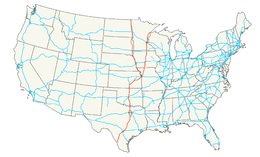NAFTA superhighway

The NAFTA superhighway is a term sometimes used informally to refer to certain existing and proposed highways intended to link Canada, Mexico, and the United States.[2][3][4] Although the term has not been used publicly by governments in an official policy context, there are some dissident beliefs about this appellation that are associated with conspiracy theories regarding alleged secret plans to undermine U.S. sovereignty.[5][6][7] Development of these routes is supported by the North American SuperCorridor Coalition as part of a NASCO Corridor. These include Interstate 35 from Laredo, Texas to the Canadian border that downgrades to a non-freeway route ending at Thunder Bay, Ontario, and Interstate 29, a spur that also downgrades to a regular highway at the border and continues to Winnipeg, Manitoba.
The term is also sometimes used to describe some additional partly built or proposed highways and supercorridors which are intended to connect the road systems of the three nations of the North American Free Trade Agreement (NAFTA) trade bloc. One of these is Interstate 69 that extends from the Canada–US border at Port Huron, Michigan, to Indianapolis, Indiana, and its mostly built extension southward to western Kentucky. In Canada, Ontario Highway 402 and other freeways in the Windsor-Quebec City Corridor can be considered a northeastward extension of this version the NAFTA superhighway. To the southwest, from western Kentucky to the Mexican border, there is currently no single superhighway yet completed. Pending completion of I-69, the main highway links to Mexico follow parts of US routes 45 and 51 from Kentucky to western Tennessee, I-155 into Missouri, parts of Interstates 55 and 40 from Missouri to Arkansas, and I-30 to the Texas stretch of I-35 that continues to the Mexican border at Laredo, Texas. The incompleted section of I-69 south of Kentucky is expected to eventually continue southwestward to the Texas Gulf Coast. It will have a spur linking to the original Pan-American route through Mexico to Laredo, and additional branches extending to the Mexican spurs that cross the border at Pharr, Texas, and Brownsville, Texas.
The CANAMEX Corridor is another major route that links the three NAFTA countries. It includes Mexican Federal Highway 15, American I-19 and I-15, and Alberta highway 2. The route is sometimes referenced as part of the NAFTA superhighway concept, but it already has a name of its own. Interstate 94 is an important east-west freeway that indirectly links the CANAMEX Corridor with the I-29 and I-35 routes of the 'NAFTA Superhighway' and the Windsor-Quebec City Corridor. The Canadian route links with the I-69 and I-94 freeways at the same Port Huron border crossing.
See also
References
- ↑ Government of Alberta: NAFTA Trade Corridors & State Truck Standards map image. Accessed 2008-07-16
- ↑ Jerome Corsi (June 12, 2006). "Bush Administration Quietly Plans NAFTA Super Highway". Human Events. Retrieved 18 August 2011.
- ↑ Mark Robinowitz (May 10, 2006). "Peak Traffic: Planning NAFTA Superhighways at the End of the Age of Oil". From the Wilderness. Archived from the original on October 8, 2009. Retrieved 18 August 2011.
- ↑ Ron Paul (October 31, 2006). "The NAFTA Superhighway". Lewrockwell. Retrieved 18 August 2011.
- ↑ "Highway To Hell? Ron Paul's worked up about U.S. sovereignty". Newsweek. December 1, 2007. Retrieved 18 August 2011.
- ↑ "Wrong Paul: Fantasy, fallacy and factual fumbles from the Republican insurgent". Factcheck. February 11, 2008. Retrieved 18 August 2011.
- ↑ Shane Dingman (December 5, 2007). "Ron Paul's worst nightmare comes true? NAFTA Superhighway a reality". The National Post. Retrieved 18 August 2011.